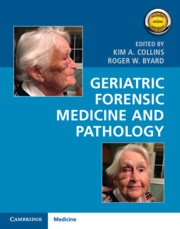Book contents
- Geriatric Forensic Medicine and Pathology
- Geriatric Forensic Medicine and Pathology
- Copyright page
- Dedication
- Epigraph
- Contents
- Preface
- Chapter 1 A History of Geriatric Medicine and Geriatric Pathology
- Chapter 2 Pathophysiology of Aging
- Chapter 3 Medicolegal Investigation of Elder Maltreatment and Deaths
- Chapter 4 The Elder Autopsy
- Chapter 5 Fatal and Non-fatal Accidents
- Chapter 6 Euthanasia
- Chapter 7 Starvation, Dehydration, Malnutrition, and Neglect
- Chapter 8 Physical Abuse and Elder Homicide
- Chapter 9 The Aging Foot
- Chapter 10 Forensic Entomology
- Chapter 11 Non-lethal Elder Abuse
- Chapter 12 Sexual Assault in Elders
- Chapter 13 Hypothermia and Hyperthermia in Elders
- Chapter 14 Suicide and Social Isolation in Elders
- Chapter 15 Cardiovascular Diseases in Elders
- Chapter 16 Lungs of the Elder
- Chapter 17 Infectious Conditions and the Immune System in Elders
- Chapter 18 Neurodegenerative Diseases in Elders
- Chapter 19 Other Neurological Conditions and Age-Related Changes
- Chapter 20 Genitourinary Conditions in Elders
- Chapter 21 The Elder Organ and Tissue Donor
- Chapter 22 The Gastrointestinal Tract in the Elder
- Chapter 23 Hematological Conditions
- Chapter 24 The Oral Cavity of the Elder
- Chapter 25 The Anthropology of Aging
- Chapter 26 Endocrinology and Diabetes in the Elder
- Chapter 27 Toxicology of the Elder
- Chapter 28 Cardiopulmonary Resuscitation-Related Injuries in Elders
- Chapter 29 Imaging of Elders
- Chapter 30 Forensic Radiology and Elders
- Chapter 31 Iatrogenic Deaths in Elders
- Chapter 32 Residential Care Facility Deaths
- Chapter 33 Morbid Obesity and Frailty
- Chapter 34 Ancillary Testing and Special Dissections
- Chapter 35 The Legal Regulation of the Consequences of Aging
- Chapter 36 Death Certification
- Index
- References
Chapter 4 - The Elder Autopsy
Published online by Cambridge University Press: 11 July 2020
- Geriatric Forensic Medicine and Pathology
- Geriatric Forensic Medicine and Pathology
- Copyright page
- Dedication
- Epigraph
- Contents
- Preface
- Chapter 1 A History of Geriatric Medicine and Geriatric Pathology
- Chapter 2 Pathophysiology of Aging
- Chapter 3 Medicolegal Investigation of Elder Maltreatment and Deaths
- Chapter 4 The Elder Autopsy
- Chapter 5 Fatal and Non-fatal Accidents
- Chapter 6 Euthanasia
- Chapter 7 Starvation, Dehydration, Malnutrition, and Neglect
- Chapter 8 Physical Abuse and Elder Homicide
- Chapter 9 The Aging Foot
- Chapter 10 Forensic Entomology
- Chapter 11 Non-lethal Elder Abuse
- Chapter 12 Sexual Assault in Elders
- Chapter 13 Hypothermia and Hyperthermia in Elders
- Chapter 14 Suicide and Social Isolation in Elders
- Chapter 15 Cardiovascular Diseases in Elders
- Chapter 16 Lungs of the Elder
- Chapter 17 Infectious Conditions and the Immune System in Elders
- Chapter 18 Neurodegenerative Diseases in Elders
- Chapter 19 Other Neurological Conditions and Age-Related Changes
- Chapter 20 Genitourinary Conditions in Elders
- Chapter 21 The Elder Organ and Tissue Donor
- Chapter 22 The Gastrointestinal Tract in the Elder
- Chapter 23 Hematological Conditions
- Chapter 24 The Oral Cavity of the Elder
- Chapter 25 The Anthropology of Aging
- Chapter 26 Endocrinology and Diabetes in the Elder
- Chapter 27 Toxicology of the Elder
- Chapter 28 Cardiopulmonary Resuscitation-Related Injuries in Elders
- Chapter 29 Imaging of Elders
- Chapter 30 Forensic Radiology and Elders
- Chapter 31 Iatrogenic Deaths in Elders
- Chapter 32 Residential Care Facility Deaths
- Chapter 33 Morbid Obesity and Frailty
- Chapter 34 Ancillary Testing and Special Dissections
- Chapter 35 The Legal Regulation of the Consequences of Aging
- Chapter 36 Death Certification
- Index
- References
Summary
The autopsy is a medical and surgical procedure designed to holistically examine the entire body. Autopsies of elders are often not performed in our society, particularly if any substantial medical history is known, even when death occurs outside a medical facility. Reasons for this surround issues of resources and generally, in the context of a comprehensive death investigation system, such omissions may be acceptable.
- Type
- Chapter
- Information
- Geriatric Forensic Medicine and Pathology , pp. 51 - 71Publisher: Cambridge University PressPrint publication year: 2020
References
- 1
- Cited by

